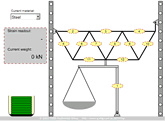Virtual Experiment: The Statical Equilibrium of Plane Frameworks
Three triangular frameworks made of steel, aluminium and CFRP, assembled with different fabrication techniques are tested by the undergraduates at CUED each year, in the Structures Laboratory. A simulation of that experiment is provided here.
Objectives
- To investigate the load distribution within three triangulated structural frameworks both by experiment and by calculations based on the principle of statical equilibrium and the hypothesis of frictionless pin-joints between members, and
- to compare some aspects of the performance of structures fabricated from welded steel tubing, extruded aluminium section and carbon fibre reinforced plastic (CFRP).
Virtual Experiment Instructions
Please make sure you have a copy of the experiment instruction document.
Load the structure by dragging and dropping the weights. The strains on each of the members can be read by placing your mouse cursor over the relevant strain gauge. These record the change in axial length of each member under load. All the gauges have the same calibration factor.
Details of the laboratory procedure report are provided in section 4 of the experiment instruction document and guidance on how to write the report in section 6.
We start by recording the way in which the strains in the members vary with the magnitude of the load in the scale pan P, and hence with the load on the structure Q. Of particular interest will be to determine the bar forces in all three frames when Q = 5 kN.
Each frame will be loaded in three phases; phase 1 (loading from P = 0 to 0.996 kN), phase 2 (loading from P = 0.996kN to 2.242 kN) and phase 3 (unloading).
Launch the virtual experiment.


